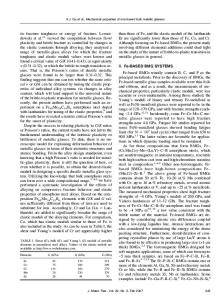Tough Hypoeutectic Zr-Based Bulk Metallic Glasses
- PDF / 940,885 Bytes
- 8 Pages / 593.972 x 792 pts Page_size
- 35 Downloads / 521 Views
I.
INTRODUCTION
IN a series of bulk metallic glasses (BMGs), the average state of atomic bonds, which can be conceived as an intermediate state between the covalent and metallic bonds, can be estimated by Poisson’s ratio.[2] Poisson’s ratio is also one of the useful factors in evaluating the fragility and toughness of metallic glasses.[3] Although the atomic bond state of a BMG is basically of metallic nature, the degree of covalent bonding probably relates to the embrittlement due to the low mobility of atoms under local deformation. A glass structure is characterized by its unique homogeneity on the macroscopic scale, even though inhomogeneous structural features can be seen on a microscopic scale, for example, a mixed structure of weakly bonded (liquidlike) and strongly bonded (solidlike) regions.[4,5] Since the metallic-bond nature is enhanced in the weakly bonded region, the distribution and abundance ratio of the weakly bonded region influence the toughness of a metallic glass. In fact, Zr-enriched Zr-Ni-Cu-Al BMGs exhibit significant softening[6] because of a decrease in Young’s modulus and an increase in Poisson’s ratio. The significant softening [1]
YOSHIHIKO YOKOYAMA, Associate Professor, TORU KAWAMATA, Graduate Student, KAZUMASA SUGIYAMA and AKIHISA INOUE, Professors, are with the Institute for Materials Research, Tohoku University, Katahira, Sendai 980-8577, Japan. Contact e-mail: [email protected] HITOO TOKUNAGA, Associate Professor, and KAZUTAKA FUJITA, Professor, are with the Department of Mechanical Engineering, Ube National College of Technology, Ube 755-8555, Japan. ALAIN REZA YAVARI, Professor, is with SIMAP-CNRS, Institut Polytechnique de Grenoble, BP 75 Saint Martin d’Heres Campus, Saint Martin d’Heres 38402, France, and is also with WPI-AIMR, Tohoku University. TOHRU YAMASAKI, Professor, is with the Department of Material Science and Engineering, University of Hyogo, Shosha 671-2201, Japan. PETER K. LIAW, Professor, is with the Department of Materials Science and Engineering, The University of Tennessee, Knoxville, TN 37996. Manuscript submitted April 30, 2010. Article published online February 24, 2011 1468—VOLUME 42A, JUNE 2011
in Zr-enriched BMGs might be caused by the formation of continuous networks of weakly bonded regions. Shear deformation of a random structure is accompanied by volume expansion along a direction normal to the shear plane.[7] That is, the open-volume condensed or weakly bonded region in the random structure promotes local shear deformation in glassy alloys. On the basis of Reference 8, a shear-transformation theory is now used to analyze the inhomogeneous deformation at the glass transition temperature (Tg). In particular, a multiple shear band formation is considered to be one of the significant factors involved in immediate accommodation of the localized stress to avoid accidental catastrophic fracture in BMGs.[9] Since multiple shear band formation is presumably caused by the combination of preintroduced intermissive shear bands from shear transformation zones (STZs
Data Loading...











